|
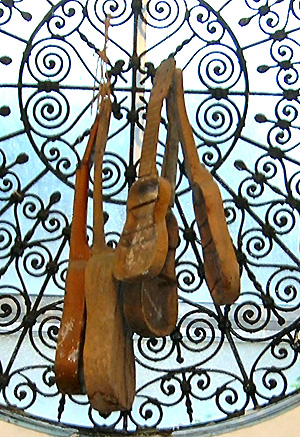 In February of 2008 Tina and I traveled to Veracruz Mexico in search of the descendents of the baroque guitar and vihuela, the Jarana and the musicians who played the music of the Son Jarocho1. In February of 2008 Tina and I traveled to Veracruz Mexico in search of the descendents of the baroque guitar and vihuela, the Jarana and the musicians who played the music of the Son Jarocho1.
Hernan Cortés and the conquistadors landed in the spot now called Veracruz City in 1519. It was the site of most Spanish immigration into Mexico, and is the oldest city in Mexico.
Owing to a revival of the Jarana tradition in Mexico, the web is full of articles and debates concerning the connection between the Jarana and other Latin American chordophones (including the charango of Bolivia, Peru, Chile and Argentina) and the baroque guitar. Nearly all of these articles explore the music and tuning of these instruments, looking for artifacts of the earlier baroque guitar tradition.
As an historical instrument maker and a builder of the baroque guitar, I chose instead to undertake a morphological investigation into the physical characteristics of surviving antique instruments in Veracruz. What is generally agreed upon is that pre-hispanic instruments used by native American indian cultures were essentially aerophones (wind instruments) and that the concept of stringed instruments was entirely unknown until after the Spanish conquest.2 It is clear that early Spanish soldiers and and colonizers brought the baroque guitar, the harp and the "vihuela"3 into Mexico during the 17th and 18th centuries.
Present-day debate centers around exactly how and to what extent the indigenous inhabitants of Mexico and South America developed their own versions of the european instruments which they first heard in the hands of the Spanish newcomers. Much of the discussion has centered around how they incorporated aspects of the music they heard into their own musical tradition. Interested readers should refer to an important article on the Son tradition and the important group Mono Blanco (White Monkey). Also worth reading is an excellent explanation of the Son revival by Eugene Rodríguez
Spanish Language School
My own interest centers around surviving instruments and the traditions of
Mexican luthiers who are currently building Jaranas. To this end, I traveled
first to Veracruz to improve my Spanish. I wanted to be able to move beyond
my everyday conversational Spanish and work on all the verb forms and
idioms that would allow me to more clearly understand my conversations
with musicians and luthiers in the Veracruz area. Any speaker of Spanish
will immediately recognize how difficult this can be! I enrolled in a
three-week total immersion Spanish
school in Veracruz which catapulted my Spanish to a much more useful
level.
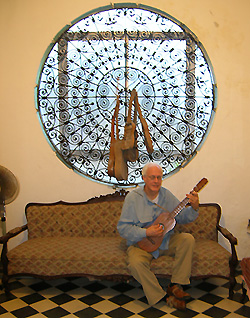 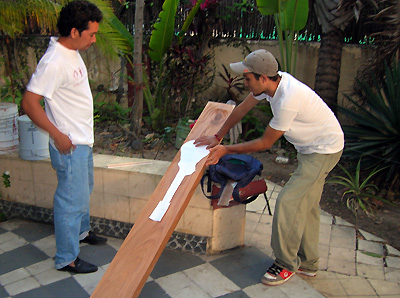 Jarana School Jarana School
At
the same time, my wife Tina and I sought out Gilberto Gutierrez and enrolled
in his Jarana school The Cason on Primera de Mayo street, which
was less than a mile away from the Spanish school. Our instructor was
Nacho Hernandez, who is well known in Fandango circles and proved to be
an excellent teacher. He was kind enough to loan us a Jarana for the three
weeks that we spent at the Spanish school in Veracruz, to practice with.
At right, Nacho inspects a three-inch thick mahagony board that will be used to produce two Jaranas.
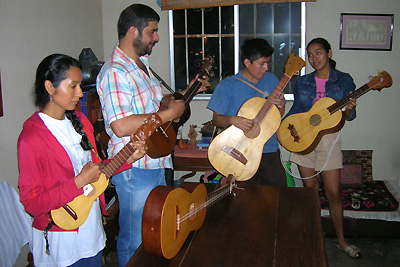 Oldest Jarana Found Oldest Jarana Found
One evening, Gilberto invited us to his home where we were entertained by an informal gathering of musicians, including his wife Gisela. Gilberto showed me two antique Jaranas that he had restored. I immediately noticed that beneath the fingerboard he had glued on was a row of slots that held the original frets. Clearly, the original fingerboard was on the same plane as the soundboard, and not raised above it. I then asked if he had any older Jaranas that he had not restored, and he produced an instrument even more interesting. It had no fingerboard at all, but it did have tied on string frets. The condition of the string and the knots indicated that the frets were as old as the instrument itself! Thankfully, he had no plans to restore this instrument.
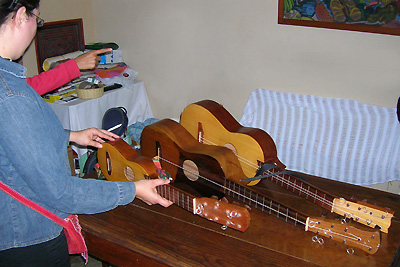 The music of
the Son Jorocho tradition and the Jarana is a living, changing tradition.
From the very beginning the indigenous inhabitants of the Americas developed
their own versions of the european instruments which they first heard
in the hands of the Spanish conquerers. They also incorporated many aspects
of the music they heard into their own musical tradition, creating a unique
sound and musical personality which is far removed from that of the 16th-century
Spanish vihuela and the baroque guitar. As an example of the flexibility
of this tradition, Gilberto made a special Jarana for his own style of
playing. Although the traditional one has 5 courses, his new Jarana has
three courses triple strung with 9 strings for 3 notes. It sits in the
center in this photo, the instrument with 9 pegs. Gilberto is an acknowledged
virtuoso of the Jarana, and in his hands the rhythmic and harmonic complexities
of the music are astounding--often taking on the contrapuntal feeling
of Bach.4 The music of
the Son Jorocho tradition and the Jarana is a living, changing tradition.
From the very beginning the indigenous inhabitants of the Americas developed
their own versions of the european instruments which they first heard
in the hands of the Spanish conquerers. They also incorporated many aspects
of the music they heard into their own musical tradition, creating a unique
sound and musical personality which is far removed from that of the 16th-century
Spanish vihuela and the baroque guitar. As an example of the flexibility
of this tradition, Gilberto made a special Jarana for his own style of
playing. Although the traditional one has 5 courses, his new Jarana has
three courses triple strung with 9 strings for 3 notes. It sits in the
center in this photo, the instrument with 9 pegs. Gilberto is an acknowledged
virtuoso of the Jarana, and in his hands the rhythmic and harmonic complexities
of the music are astounding--often taking on the contrapuntal feeling
of Bach.4
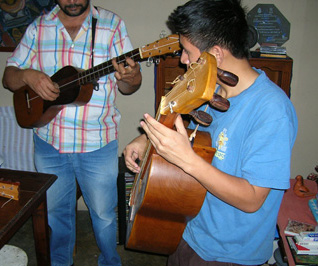 Jarana Construction Jarana Construction
Changes to the instrument were demanded in part by climate. The Jarana is not built up with separate sides and back and neck like the classical guitar. The neck, back, sides and pegbox are made from one piece of wood--even the very large ones like the leona shown in this photo. It has a different sound than a glued-up instrument with flexible back and sides. Fandangos and impromptu gatherings of musicians normally take place outside.5 It's very humid and hot, and the musicians may even be wet. Early luthiers discovered the advantages of a one-piece body and neck. This tradition is typical of medieval instruments that were made from one piece with a glued-on top for the same reason--the unreliability of glues. There is now a modern version of the Jarana built like a small classical guitar, and it is this version that you may see in the tourist areas.
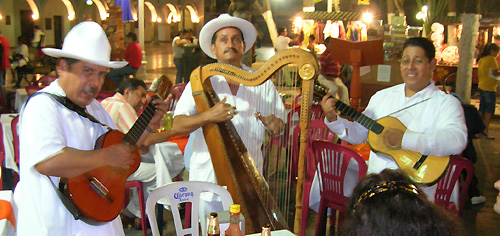
We were often entertained in outdoor restaurants by groups of musicians who wandered from table to table. Many of these musicians play a modernized version of the Jarana, as shown in this photo. They are basically miniature classical guitars, with fewer braces under the soundboard. The neck and sides and back are glued up just like a classical guitar and tuning machines are used instead of wooden pegs. The bridge looks like a classical guitar bridge. They are strung in five courses, like a Jarana, but are not as robust or as loud as a Jarana carved from a solid piece of wood. They have a thick, shiny varnish instead of the duller finish usually found on more authentic Jaranas.
Part 2: Lutherie traditions in Mexico--Construction of the Jarana.
| 

 In February of 2008 Tina and I traveled to Veracruz Mexico in search of the descendents of the baroque guitar and vihuela, the Jarana and the musicians who played the music of the Son Jarocho1.
In February of 2008 Tina and I traveled to Veracruz Mexico in search of the descendents of the baroque guitar and vihuela, the Jarana and the musicians who played the music of the Son Jarocho1.
 Jarana School
Jarana School Oldest Jarana Found
Oldest Jarana Found The music of
the Son Jorocho tradition and the Jarana is a living, changing tradition.
From the very beginning the indigenous inhabitants of the Americas developed
their own versions of the european instruments which they first heard
in the hands of the Spanish conquerers. They also incorporated many aspects
of the music they heard into their own musical tradition, creating a unique
sound and musical personality which is far removed from that of the 16th-century
Spanish vihuela and the baroque guitar. As an example of the flexibility
of this tradition, Gilberto made a special Jarana for his own style of
playing. Although the traditional one has 5 courses, his new Jarana has
three courses triple strung with 9 strings for 3 notes. It sits in the
center in this photo, the instrument with 9 pegs. Gilberto is an acknowledged
virtuoso of the Jarana, and in his hands the rhythmic and harmonic complexities
of the music are astounding--often taking on the contrapuntal feeling
of Bach.4
The music of
the Son Jorocho tradition and the Jarana is a living, changing tradition.
From the very beginning the indigenous inhabitants of the Americas developed
their own versions of the european instruments which they first heard
in the hands of the Spanish conquerers. They also incorporated many aspects
of the music they heard into their own musical tradition, creating a unique
sound and musical personality which is far removed from that of the 16th-century
Spanish vihuela and the baroque guitar. As an example of the flexibility
of this tradition, Gilberto made a special Jarana for his own style of
playing. Although the traditional one has 5 courses, his new Jarana has
three courses triple strung with 9 strings for 3 notes. It sits in the
center in this photo, the instrument with 9 pegs. Gilberto is an acknowledged
virtuoso of the Jarana, and in his hands the rhythmic and harmonic complexities
of the music are astounding--often taking on the contrapuntal feeling
of Bach.4 Jarana Construction
Jarana Construction